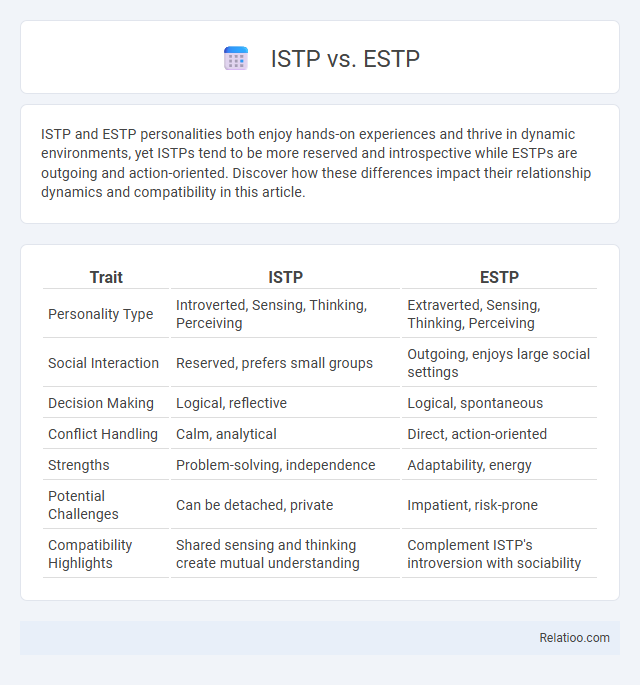ISTP and ESTP personalities both enjoy hands-on experiences and thrive in dynamic environments, yet ISTPs tend to be more reserved and introspective while ESTPs are outgoing and action-oriented. Discover how these differences impact their relationship dynamics and compatibility in this article.
Table of Comparison
| Trait | ISTP | ESTP |
|---|---|---|
| Personality Type | Introverted, Sensing, Thinking, Perceiving | Extraverted, Sensing, Thinking, Perceiving |
| Social Interaction | Reserved, prefers small groups | Outgoing, enjoys large social settings |
| Decision Making | Logical, reflective | Logical, spontaneous |
| Conflict Handling | Calm, analytical | Direct, action-oriented |
| Strengths | Problem-solving, independence | Adaptability, energy |
| Potential Challenges | Can be detached, private | Impatient, risk-prone |
| Compatibility Highlights | Shared sensing and thinking create mutual understanding | Complement ISTP's introversion with sociability |
Understanding ISTP and ESTP Personality Types
ISTP and ESTP personality types both belong to the SP (Sensing-Perceiving) temperament group, characterized by practical, action-oriented traits, but ISTPs tend to be more reserved and analytical while ESTPs are outgoing and energetic. Emotional stability in ISTPs often manifests as calmness under pressure and a preference for logical problem-solving, whereas ESTPs may display higher impulsivity and risk-taking behaviors due to their social and spontaneous nature. Understanding the nuanced differences between ISTP and ESTP emotional responses enhances interpersonal communication and stress management strategies tailored to each type's unique cognitive style.
Key Similarities Between ISTP and ESTP
ISTP and ESTP personalities share a strong preference for sensing and perceiving, which drives their practical approach to problem-solving and adaptability in dynamic situations. Both types exhibit high emotional stability through their ability to remain calm under pressure and maintain a focus on immediate, tangible results rather than abstract emotions. Their shared traits include quick decision-making, hands-on learning, and a preference for experiencing the world directly, which enhances their resilience and steady emotional responses.
Core Differences: ISTP vs ESTP
ISTP individuals exhibit a preference for internal reflection and practical problem-solving with a calm and measured approach, while ESTPs are action-oriented, thrive on external stimulation, and display high adaptability in dynamic environments. Emotional stability in ISTPs tends to manifest through controlled responses and reserved expression, contrasting with ESTPs who often express emotions more openly and respond impulsively to immediate challenges. Core differences include ISTP's introspective, analytical mindset versus ESTP's spontaneous, energetic behavior, which shapes how each manages stress and engages with the world around them.
Cognitive Functions Breakdown
ISTP and ESTP personalities both utilize dominant Extraverted Sensing (Se), enhancing their acute awareness of the physical environment and promoting hands-on problem-solving skills; however, ISTPs primarily rely on Introverted Thinking (Ti) for logical analysis, while ESTPs emphasize Extraverted Thinking (Te) for efficient decision-making and external organization. Emotional stability varies as ISTPs' strong Ti supports internal emotional regulation and reflective processing, whereas ESTPs' Te engagement often externalizes stress responses, leading to more reactive behaviors. The inferior functions, Introverted Feeling (Fi) in ESTPs and Extraverted Feeling (Fe) in ISTPs, further influence emotional expression, with ESTPs sometimes struggling to acknowledge personal values and ISTPs finding it challenging to align with social harmony.
Communication Styles Compared
ISTP and ESTP personalities differ significantly in communication styles, with ISTPs favoring concise, logical dialogue and ESTPs excelling in energetic, persuasive interaction. Emotional stability influences these styles by affecting responsiveness and stress management; ESTPs often display greater emotional expressiveness, while ISTPs maintain a calm, composed demeanor. Understanding Your emotional stability can enhance how you adapt communication approaches in various social or professional settings.
Decision-Making Approaches
ISTP and ESTP personalities both exhibit decisive decision-making but differ in emotional stability and cognitive focus; ISTPs prioritize logical analysis and tend to maintain emotional composure under pressure, leading to more calculated choices. ESTPs rely on immediate sensory input and thrive on spontaneity, showing higher emotional expressiveness which can affect their decision-making flexibility. Emotional stability enhances ISTPs' preference for structured problem-solving, while ESTPs' adaptability is balanced by emotional responsiveness influencing risk-taking behaviors.
Social Interaction and Friendships
ISTP individuals often exhibit emotional stability through calm and composed behavior, making their social interactions practical and straightforward yet sometimes reserved. ESTP personalities thrive on energetic, spontaneous social engagement, displaying high emotional expressiveness that fosters dynamic friendships and immediate connections. Both types value loyalty in friendships, but ISTPs prefer deeper, smaller circles while ESTPs enjoy a broader social network with diverse interactions.
Career Preferences and Work Environments
ISTP individuals excel in careers that require problem-solving and technical skills, thriving in structured yet flexible work environments where they can work independently. ESTP personalities prefer dynamic, fast-paced settings that allow for social interaction and hands-on activities, often excelling in sales, marketing, or emergency response roles. Your emotional stability influences how you handle workplace stress and decision-making, with higher stability contributing to resilience in high-pressure careers.
Strengths and Challenges of ISTP vs ESTP
ISTP personalities excel in practical problem-solving and adaptability, thriving in hands-on tasks that require logical analysis, while ESTPs showcase strong interpersonal skills and quick decision-making in dynamic environments. ISTPs often face challenges with emotional expression and social interaction, whereas ESTPs may struggle with impulsivity and managing long-term consequences. Emotional stability tends to be higher in ISTPs due to their introspective nature, contrasting with ESTPs who may experience more emotional volatility linked to their extroverted, sensation-seeking tendencies.
Tips for Harmonious Relationships
ISTP and ESTP personalities differ in emotional stability, with ISTPs often being more introspective and reserved, while ESTPs tend to be outgoing and expressive. Building harmonious relationships requires ISTPs to practice open emotional communication and ESTPs to develop patience and active listening skills. Fostering mutual respect through understanding each type's emotional processing enhances stability and focus in the relationship.

Infographic: ISTP vs ESTP
 relatioo.com
relatioo.com